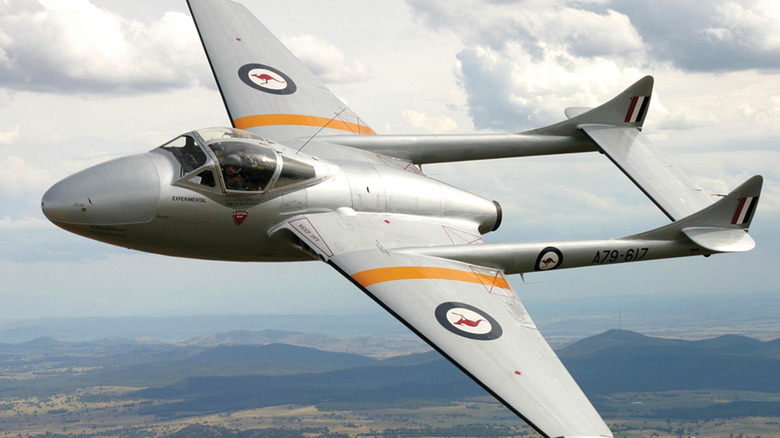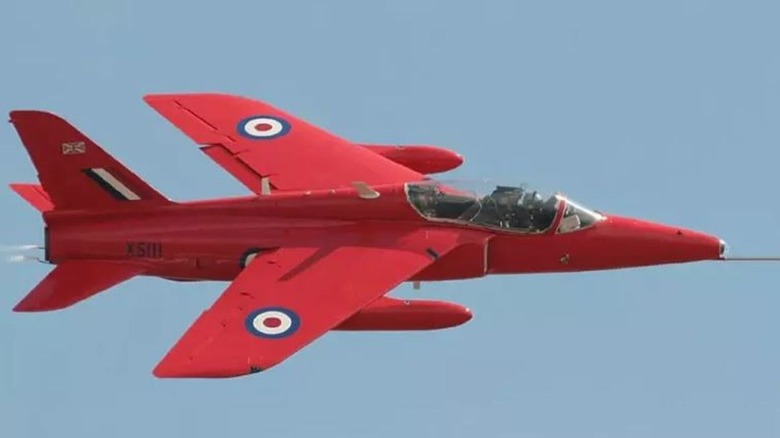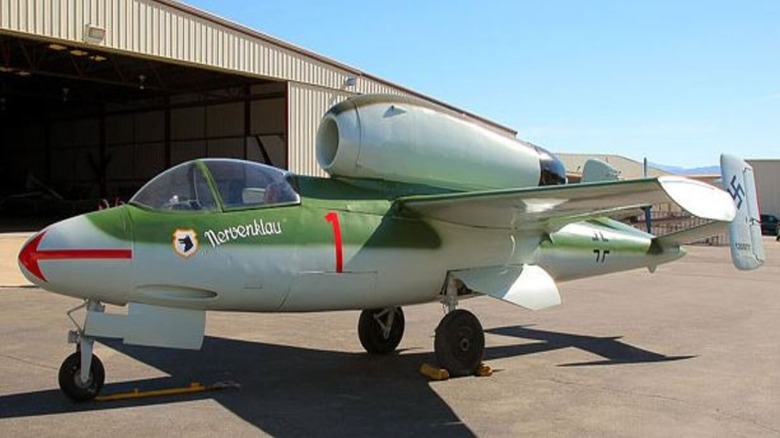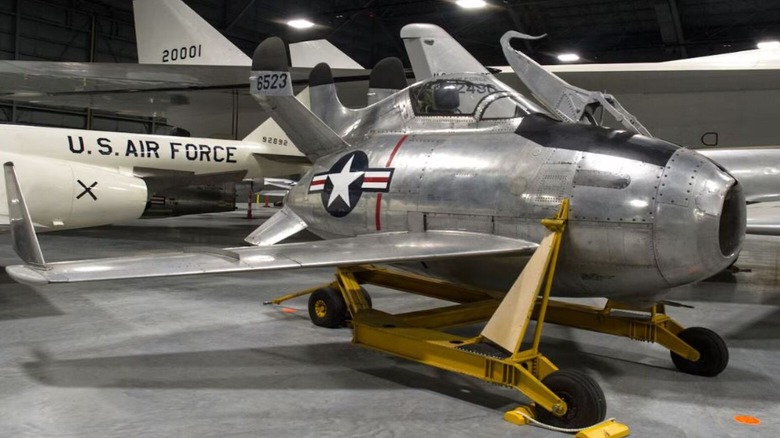4 Of The Smallest Fighter Jets In The World
The origins of the fighter jet can be traced to early World War II, when the Messerschmitt aircraft company began development on Projekt 1065 in 1939. This first attempt at a jet fighter resulted in the Messerschmitt Me 262, one of the fastest fighters of the era, entered service with the German Luftwaffe in April 1944. Within three months, the British Royal Air Force responded with the Gloster Meteor, which launched in July 1944. These two aircraft were instrumental in advancing aircraft design, paving the way for jets as the fighter aircraft of the future, and soon, even more advanced jet fighters were produced. These early fighter jets came with unorthodox designs, several of which had very compact dimensions, making them some of the smallest fighter jets.
One of these is the aircraft pictured above, called the De Havilland Vampire. This is another fighter created during World War II, which was built by de Havilland Aviation. The Vampire was the RAF's second fighter jet, making its first flight in September 1943, but it only entered service after the war had ended in 1946. With a unique twin-boom design this gave the jet good handling and speed, and because it was made of wood and metal, it was light and agile.
As one of the pioneer fighter jets, the Vampire is small, with only a 37.9-foot wingspan, weighs 12,359 pounds, and is just 8.79 feet high and 30 feet long. To put this in perspective, the Vampire is smaller than the average school bus in America, which is 35 feet, and is lighter than a 2025 Ford F250 crew cab pickup that weighs 6,864 pounds. Over 4,300 Vampires were produced and are considered as one of the most successful RAF aircraft, until it was finally decommissioned by the RAF in 1966.
Folland Gnat
Created by Folland Aircraft in the early 1950s, the Folland Gnat was envisioned as a small subsonic jet fighter with a swept-wing design. Developed from the Folland Midge, the Gnat had a bigger wingspan, which could mount 30-millimeter cannon weaponry, and larger air intakes to accommodate the Orpheus 100 engine. The Gnat prototype flew in 1955, and by 1958, the British government gave an order for 14 aircraft to be used as jet training craft. While initially marketed as a fighter jet, the RAF saw another use for the Gnat as it was looking for a replacement for the de Havilland Vampire, which was used as a trainer.
Despite being relegated to trainer duty by the RAF, the Gnat saw actual service as a fighter jet with the air forces of Finland and India, who later built a domestic version of the Gnat under license. A total of 432 Gnats were built in the United Kingdom, together with the 250 licensed versions that India's Hindustan Aeronautics Limited made. The most well-known version of the Gnat is the Folland Fo.144 Gnat T.1, which became the show plane of the RAF Yellowjacks aerobatic display team and later by its successor, the Red Arrows.
The Gnat was a light and compact jet; its maximum weight was 8,630 pounds, with a wingspan of 24 feet, and it was only 9 feet 8 inches high and 31 feet 9 inches long. When compared to a modern fighter, like the F-22 Raptor, which has a wingspan of 44.5 feet, is 62 feet long, and is 16.6 feet high, the Gnat is very small, roughly only half its length and width.
Heinkel He 162-A
Known as the Volksjäger or People's Fighter, the Heinkel He 162A was a German jet fighter created by Heinkel Flugzeugwerke during the closing months of World War II. With Germany losing the war, the Heinkel He 162A was a proposed wonder weapon, an aircraft with a basic design and easy to manufacture. Planned to be produced rapidly by semi-skilled workers using cheap materials, the Heinkel He 162A would also have simple controls to facilitate quick training and adoption, as these were supposed to be piloted by inexperienced Hitler Youth.
From receiving the contract to building the prototype, the He 162 was built in record time, taking a little over two months to complete. Because of supply and material shortages, several of the He 162's key components, including its wings and tail fins, were made of wood, while its fuselage and engine mounts were made of metal, making the jet structurally weak, and it can be considered one of the worst fighter jets ever made. Powered by a BMW 003 engine, the He 162 was very fast, capable of reaching 562 mph, but had a limited flight time of just 30 minutes due to its small fuel tank. Because its production came late during the war, only 350 Heinkel He 162s were made, and the Luftwaffe only received 120 before the war's end.
With a total length of 29 feet and 7 inches, the Heinkel He 162A is half the length of a 10-pin bowling lane, which measures slightly over 60 feet. Its wingspan is 23 feet, 7 inches, meaning a hang glider, with a 29-foot wingspan, is wider. Lastly, with a weight of only 5,490 pounds, it is nearly 1,000 pounds lighter than a 2023 RAM crew cab that weighs 6,483 pounds.
McDonnell XF-85 Goblin
Due to its diminutive size, the McDonnell XF-85 Goblin would hardly be thought of as a long-range bomber escort and fighter, but filling these roles was why it was built. By the end of World War II, the U.S. military was developing a new long-range bomber with greater range and payload capacity than anything before. The new B-36 Peacemaker, had a very long range, required protection, and no existing fighter escorts had the same range. As a response, McDonnell Aircraft Corporation proposed an unconventional solution by creating a fighter that would be internally carried and launched by the bomber, like a parasite, and could later return to it.
By 1947, McDonnell Aircraft was able to build two prototypes of the X-85, a tiny jet with a rounded fuselage and a three-fin stabilizer on its rear. The XF-85, now called the Goblin, was powered by the turbojet XJ34 Westinghouse engine that made 3,000 pounds of thrust, capable of pushing the Goblin to 650 mph. It had a fuel tank that carried 112 gallons, allowing for an hour and 30 minutes of flight time, and for its weapons, the XF-85 came with four .50 caliber machine guns. The Goblin made its first test flights by 1948, but by the following year, the program was cancelled, citing inferior performance to other fighter jets and issues with its return docking system.
Measuring only 14 feet long, 8 feet high, and 21 feet wide, the XF-85 is tiny, as a 2021 Honda CR-V, measuring 15.1 feet, is longer. Also, it is small enough to be parked in a typical suburban home because the average width of a two-car garage is 24 feet. While ultimately a failure, the XF-85 concept was a testament to bold and out-of-the-box aviation engineering and design.



